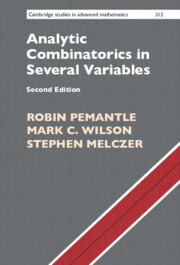Refine search
Actions for selected content:
6950 results in Algorithmics, Complexity, Computer Algebra, Computational Geometry
6 - Laurent series, amoebas, and convex geometry
- from Part II - Mathematical Background
-
- Book:
- Analytic Combinatorics in Several Variables
- Published online:
- 08 February 2024
- Print publication:
- 15 February 2024, pp 134-166
-
- Chapter
- Export citation
2 - Generating functions
- from Part I - Combinatorial Enumeration
-
- Book:
- Analytic Combinatorics in Several Variables
- Published online:
- 08 February 2024
- Print publication:
- 15 February 2024, pp 17-59
-
- Chapter
- Export citation
Dedication
-
- Book:
- Analytic Combinatorics in Several Variables
- Published online:
- 08 February 2024
- Print publication:
- 15 February 2024, pp v-vi
-
- Chapter
- Export citation
8 - Effective computations and ACSV
- from Part III - Multivariate Enumeration
-
- Book:
- Analytic Combinatorics in Several Variables
- Published online:
- 08 February 2024
- Print publication:
- 15 February 2024, pp 221-244
-
- Chapter
- Export citation
10 - Multiple point asymptotics
- from Part III - Multivariate Enumeration
-
- Book:
- Analytic Combinatorics in Several Variables
- Published online:
- 08 February 2024
- Print publication:
- 15 February 2024, pp 291-338
-
- Chapter
- Export citation

Analytic Combinatorics in Several Variables
-
- Published online:
- 08 February 2024
- Print publication:
- 15 February 2024

Random Graphs and Complex Networks
-
- Published online:
- 08 February 2024
- Print publication:
- 08 February 2024
Frontmatter
-
- Book:
- Random Graphs and Complex Networks
- Published online:
- 08 February 2024
- Print publication:
- 08 February 2024, pp i-iv
-
- Chapter
- Export citation
8 - Small-World Phenomena in Preferential Attachment Models
- from Part III - Small-World Properties of Random Graphs
-
- Book:
- Random Graphs and Complex Networks
- Published online:
- 08 February 2024
- Print publication:
- 08 February 2024, pp 326-380
-
- Chapter
- Export citation
7 - Small-World Phenomena in Configuration Models
- from Part III - Small-World Properties of Random Graphs
-
- Book:
- Random Graphs and Complex Networks
- Published online:
- 08 February 2024
- Print publication:
- 08 February 2024, pp 289-325
-
- Chapter
- Export citation
Dedication
-
- Book:
- Random Graphs and Complex Networks
- Published online:
- 08 February 2024
- Print publication:
- 08 February 2024, pp v-vi
-
- Chapter
- Export citation
Index
-
- Book:
- Random Graphs and Complex Networks
- Published online:
- 08 February 2024
- Print publication:
- 08 February 2024, pp 486-490
-
- Chapter
- Export citation
Part I - Preliminaries
-
- Book:
- Random Graphs and Complex Networks
- Published online:
- 08 February 2024
- Print publication:
- 08 February 2024, pp 1-2
-
- Chapter
- Export citation
Part II - Connected Components in Random Graphs
-
- Book:
- Random Graphs and Complex Networks
- Published online:
- 08 February 2024
- Print publication:
- 08 February 2024, pp 95-96
-
- Chapter
- Export citation
5 - Connected Components in Preferential Attachment Models
- from Part II - Connected Components in Random Graphs
-
- Book:
- Random Graphs and Complex Networks
- Published online:
- 08 February 2024
- Print publication:
- 08 February 2024, pp 189-242
-
- Chapter
- Export citation
Possible Course Outlines
-
- Book:
- Random Graphs and Complex Networks
- Published online:
- 08 February 2024
- Print publication:
- 08 February 2024, pp xv-xvi
-
- Chapter
- Export citation
Part IV - Related Models and Problems
-
- Book:
- Random Graphs and Complex Networks
- Published online:
- 08 February 2024
- Print publication:
- 08 February 2024, pp 381-382
-
- Chapter
- Export citation
Contents
-
- Book:
- Random Graphs and Complex Networks
- Published online:
- 08 February 2024
- Print publication:
- 08 February 2024, pp vii-x
-
- Chapter
- Export citation
1 - Introduction and Preliminaries
- from Part I - Preliminaries
-
- Book:
- Random Graphs and Complex Networks
- Published online:
- 08 February 2024
- Print publication:
- 08 February 2024, pp 3-47
-
- Chapter
-
- You have access
- Export citation
Part III - Small-World Properties of Random Graphs
-
- Book:
- Random Graphs and Complex Networks
- Published online:
- 08 February 2024
- Print publication:
- 08 February 2024, pp 243-244
-
- Chapter
- Export citation
